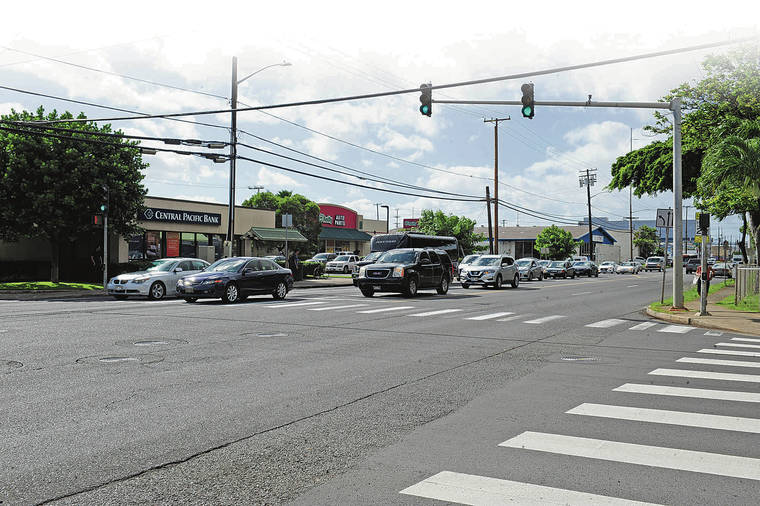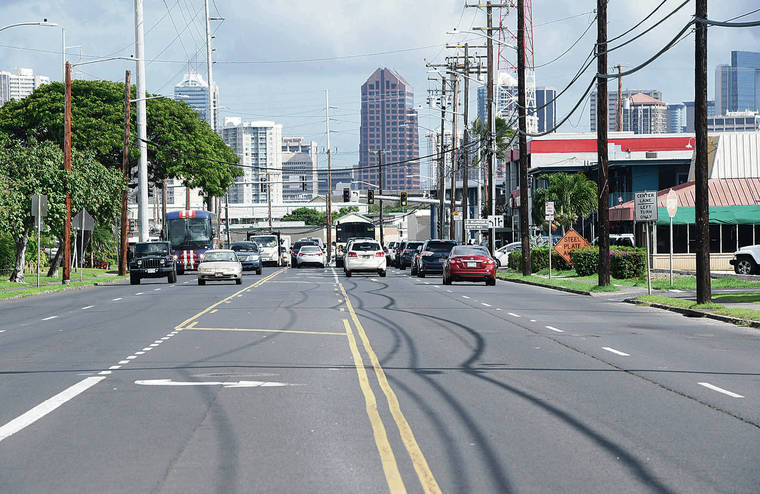Major rail-related construction along congested Dillingham Boulevard is being delayed until early next year to give the city more time to finalize its traffic management plan, and the city is considering providing tax relief to property owners and their tenants during what is expected to be a hellish two years of construction.
Earlier this month the rail authority said major construction to relocate utilities to make way for the rail line along the Dillingham corridor could begin as early as Nov. 12, but on Wednesday members of the Honolulu City Council’s Transportation Committee were told the traffic plan will not be ready by then.
“We’re looking at hopefully first quarter next year,” said Amalia Hilliard, East Area deputy project manager for the Honolulu Authority for Rapid Transportation.
HART Executive Director Andrew Robbins said HART is pushing to get major work underway in January but needs to get its traffic plan completed and submitted to the city Department of Transportation Services so that agency can issue permits for the necessary lane closures and construction in the right-of-way.
HART will then restrict traffic flow on Dillingham to one lane in each direction to make room for major construction to begin right after the new year, he said. That will allow the rail authority to accelerate its utility relocation work and clear the way to begin building columns for the elevated rail system along Dillingham next year.
“Right now we have existing permits to work on Dillingham without closing the other lanes, so we’re going to just continue with that work and ramp up to the full closure in January,” Robbins said. “I would say early January, that’s what we’re pulling for.”
The HART strategy for minimizing the disruption from rail construction on Dillingham is to get the work done rapidly. Rail officials say crews will be working in the corridor in two 10- to 12-hour shifts each day, five days a week, with weekend work as needed. The least noisy work will be scheduled for nighttime hours, according to the rail authority.
HART now projects it will “substantially complete” the utility relocations and guideway construction in the Dillingham corridor in 24 months, which is a significant reduction from previous projections of 3-1/2 years.
HART has pledged to keep at least one lane of Dillingham Boulevard open in each direction at all times during construction, and also to keep the intersections and sidewalks open. Left turns at the intersections will be allowed as much as possible, and off-duty police officers will be used for traffic control.
Bus ridership in the corridor is the highest per capita in the city, and the city also plans to keep bus service in the corridor at “near its current schedule” during construction.
The rail authority has promised that every home and business along the corridor will have access at all times. But an estimated 20,000 to 40,000 cars travel along the Dillingham corridor each day, and the construction period will be painful for the traveling public, area residents and businesses.
Joyce Oliveira, deputy executive director of government services for HART, said she has been discussing a plan with Mayor Kirk Caldwell’s administration to review the market conditions of the Dillingham area during construction to
determine if businesses are seeing losses in rents.
“Should that run as a common theme in this area, there could be consideration of adjusting their real property taxes,” she said. The tax savings would flow down to tenants who are required to pay property taxes as part of their common area maintenance fees, she said.
“Of course, there would
be a discussion with the City Council as well as the city administration on how that proceeds,” she said.
The work in the Dillingham corridor includes burying an array of overhead utility lines, relocating underground utilities, widening the road, construction of the overhead rail guideway and construction of four rail stations.




